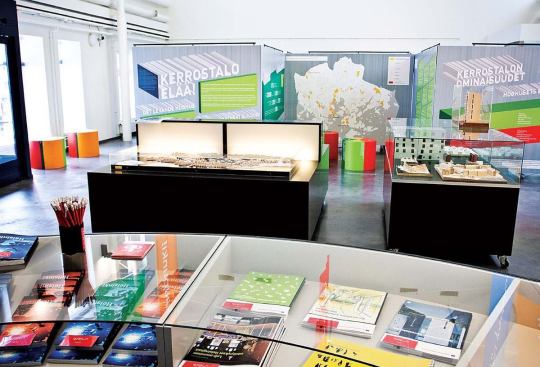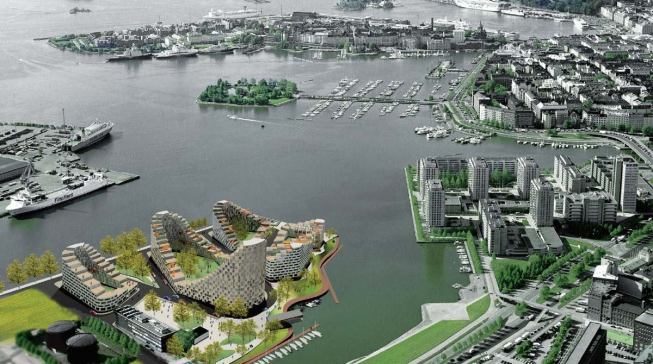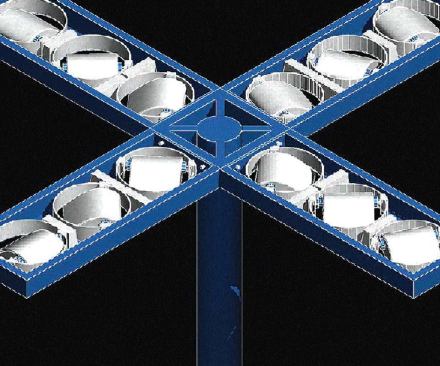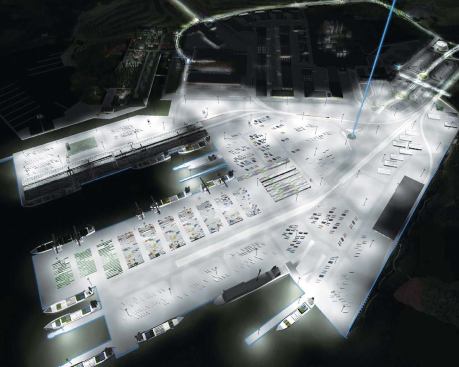City of Helsinki, City Planning Department
Laituri, or “platform” in Finnish, is an exhibition center t…
The first step toward this was, really, a leap: The city decided to shift all its commercial port operations to a site just east of the city (land that it had annexed). As of this November, the city-owned Port of Helsinki will operate out of this new harbor at Vuosaari, leaving its two former locations—a North Harbor and West Harbor that flank the peninsular city center—open for future redevelopment.
Driving around the square-mile site, project director Antti Mäkinen pointed out different structures—a gatehouse, cargo warehouses, and a striking coffee roastery clad in Cor-Ten panels—and noted the work of Helsinki architecture firm APRT, which master-planned the sprawling site, although it lost a competition to design the gatehouse tower. APRT did win another, separate competition for lighting at the port with a scheme of striking blue light poles, each topped by a large X studded with fixtures—the kind of light pole that, in America, would be lucky to find a home in the parking lot of a modern art gallery, but in Finland illuminates stacks of shipping containers.
And why not? Elsewhere around Helsinki, I saw electricity pylons and water towers that please the eye—a prerequisite, you’d think, for structures that residents have to look at day after day. Besides, in a flat country that’s cloaked in darkness much of the year, attractive man-made forms must be a welcome, even necessary, diversion.
The first architectural competition in Finland was held in 1876, for Helsinki’s Bank of Finland building; Alvar Aalto’s Paimio Sanatorium—possibly the most influential work of Finnish architecture—sprang from a competition entry in 1929. The practice of architecture in Finland today has largely been shaped by this tradition, which the muscular city government sustains by holding competitions for virtually all projects under its domain. Most all of these, and other competitions besides, are consulted on by SAFA, the Finnish Association of Architects. In 2007, according to SAFA, 25 competitions were held in Finland—20 of them invited, five open. This year, the numbers have jumped to 22 invited and 13 open. Not bad for a country with a population smaller than Missouri’s.
What this means is that young architects have a decent shot at the biggest and most exciting projects and can launch their careers on the basis of an important win. The emerging Helsinki firm ALA is a case in point. ALA was founded in 2004, not long after its four partners graduated from architecture school. (Finland does not have a registration requirement for architects.) The following year, the partners won an open competition to design the Kilden Performing Arts Center in Kristiansand, Norway, beating out about 100 other entrants. The center, its foyer inserted beneath a monumental, canted wall of oak, is under construction and expected to open in 2010. Consultants on the $200 million project include Arup.
ALA partner Janne Teräsvirta says that open competitions are “practically the only way to get going” for young Finnish architects, since it usually requires good luck or good connections to snag a commission (and besides, direct commissions are rarely offered for major projects). “It was very inspiring getting to compete equally with the best in the country while young, and also very good for [our] confidence to get success early on,” he writes in an e-mail—composed on the way back to Helsinki from Tokyo, where ALA had just participated in a competition. Teräsvirta says the Kilden project and other wins have allowed the firm to shift its focus from open competitions to invited ones, which are compensated and, obviously, restrict the field of entrants. He also points out that SAFA defines and protects competition rules to ensure that they are conducted fairly.
Another Finnish architect, Pentti Kareoja of ARK-House Architects, told me that competitions lead to the best designs—they allow architects to take more risks. (We were in his office looking at a portfolio of recent projects, including a library for the University of Helsinki and a teacher training school, both won in invited competitions.) Asked about the difference between designing for competitions and on commission, Teräsvirta plays it down, but concedes that, “Deep down, [competition projects] might have a special place for us, having to do with the feeling of winning, which we all enjoy.”
Risk-taking is surely in evidence in ALA’s design for a major housing development in Helsinki, which will replace a giant coal heap on a peninsula two scant miles from the city center, a site previously owned by Helsinki Energy. ALA proposes building three large, elliptical apartment buildings with parks at their centers. The buildings will be stepped in height, ranging from two stories at the midpoint of each ellipse to 10 or more at either end. And every “step” will be given over to a semiprivate terrace, with water views, for the residents of adjacent units.
Expected to begin construction in 2009, this Hanasaari residential area will be quite a departure for a country as steeped in functionalism as Finland. And yet, an ALA press release from earlier this year declares, “It is already safe to say that this striking design will be implemented as proposed.” With a public mandate at their backs—rather than a politician’s agenda or a developer’s profit motive—even architects can sometimes smile on the planning process.



